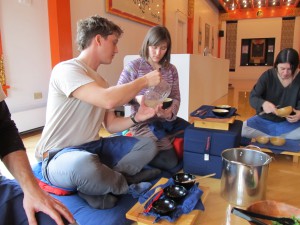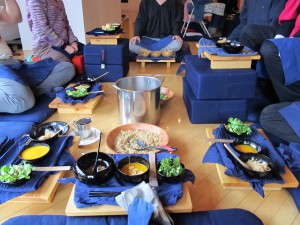Friday
Dharma TeachingsSo Much is at Stake, 3
 Maintaining the Heart of Practice
Maintaining the Heart of Practice
Part 3
by Acharya William McKeever
photos by Jessica Bizub and Patricia Hayward
Now we come to specific recommendations to continue our practice. For some of you with established practices and who have been around Shambhala for a while, this will be “old hat.” But as we have some newer students, it is good to take a few minutes to review these issues.
First, and this is for everyone: I cannot stress enough how evanescent this dathun experience is. It is so discontinuous with what has gone before, or what we jump into after, that it will fade away like mist in the morning sun, or like a dream that was so vivid during the night but by breakfast time cannot be recalled or remembered. Prajna Deer [the refuge name of one of the participants], you were quite reasonable in saying you were scared at the prospect of departing.
Yet we can rekindle this spark of practice in two ways: daily practice and attending group retreats and dharma programs.
1) Establish a daily personal practice at home. Some practical recommendations that are helpful are, first, to make a space where you can meditate that is conducive. Second, posture is important, as you know. Having the right cushions is vital to good posture, so make sure you’ve got the cushions you need. Thirdly, make a realistic plan for daily practice. Examine your current commitments, your real interest in practice, and your daily schedule. Find a time that works best for you and decide how long you are going to sit; don’t overdo it, because it is far better to be modest and steady than overly ambitious and erratic. And then, sit for that length of time. Remember, even short sittings are vastly preferable to not practicing at all.
There is a world of difference between not practicing and even simply taking the posture and relating with the experience of sitting there, being present, for say five or ten minutes, or just doing a session or two of Shambhala meditation. And a trick is that if you sit regularly for even five or ten minutes, or remember to do Shambhala meditation, you will likely find that at least some days a week you can sit for longer periods, and the flavor of Shambhala meditation will become more familiar.
One specific recommendation is that, when you return home from an intensive such as this dathun, make sure you sit at least a short period within the first 24 hours you are back. Seriously. Long-term habits are changed by such little steps.
The challenge is to make this a daily practice. That is the sort of exertion that sets the causes and conditions for real progress on the path — the path of dismantling your ego and giving rise to unborn insight.
Some of you can start to make use of Shambhala centers in this effort, and not just for programs. Make use of them for daily or weekly practice support. When I started practicing a million years ago, I was at university in New Haven, Connecticut, and there was no support for practice there. If I was lucky I could find 15 or 30 minutes every now and again when I wouldn’t be heckled by my roommates. So I drove an hour and a half each way, every Sunday, to sit at the New York Dharmadhatu, as the centers were called in those days. I was really shy, and I was suspicious of religious groups; and although I was going to Tail of the Tiger (Karme Choling’s name back then) every school vacation, I did not know about these New Yorkers. So I sat near the door in case I had to make a quick exit. I didn’t talk to anybody for six months, but I came to sit from 9-12, 2-5 and 7-10 p.m. every Sunday. It was the mainstay of my practice for my final year of college before I moved here.
 2) The second major recommendation in addition to daily practice is to continue to schedule programs, retreats, study and practice programs as a regular, ongoing part of your life.
2) The second major recommendation in addition to daily practice is to continue to schedule programs, retreats, study and practice programs as a regular, ongoing part of your life.
I used to do a lot of hiking in wilderness areas. Coming up to mountain passes between valleys, one would see an overview of one’s journey, how far one has come since the last mountain pass, and how far one has to go to the next one. Just so, periodic programs of intensive practice serve to reorient us on our journey of practice.
Ideally, when you finish one program, like this dathun, you should pencil the next one in on your calendar, being realistic about your life. There are many options for further practice and study, so please familiarize yourself with what is available, and ask the dathun staff before you go. Try and settle on a “next step” before you depart.
3) For you all in particular, I would like to add to these two recommendations a third recommendation, frankly because the practice here has been so strong and settled. This recommendation is to do solitary retreat.
We do not generally recommend solitary retreat until someone has done at least one dathun so that you have gotten into the swing of intensive practice, sitting four major sessions a day. For a first solitary retreat, at least ten days is the recommendation. The first two or three days you are arriving and settling in, and everything is new. And for the last two or three days you are thinking about and preparing to leave. So with a ten-day solitary retreat, you have a stretch of several days, like we enjoyed here in dathun, when you are really here.
I recommend you do solitary retreat at an established dharma center, because the mind is very tricky. If you are at a friend’s cabin somewhere, you might not feel safe. In a dharma center like here at Karme Choling where there are eight solitary retreat cabins, the mind can relax because you know that for several decades, hundreds of meditators have practiced in these cabins and in these woods and meadows, and all has gone well. So it can give you confidence. And there are also solitary retreat centers in Colorado and Nova Scotia.
I strongly encourage you to do solitary retreat. In this busy day and age, a period of solitary retreat is especially empowering to one’s practice. Book one before you depart on Sunday!
In general — whether you are a Buddhist or not — as an open-hearted warrior, hold the three jewels close to you. As we say in our meal chant: follow the instructions of the teachers, the dharma as your path will protect you — especially if you commit to daily practice — and the sangha as your companions will be your guide.





Jul 27, 2013
Reply
Trying to reach Bill because it has been too long-do you have email where i get get a hello to him?
Mahalo, Dean